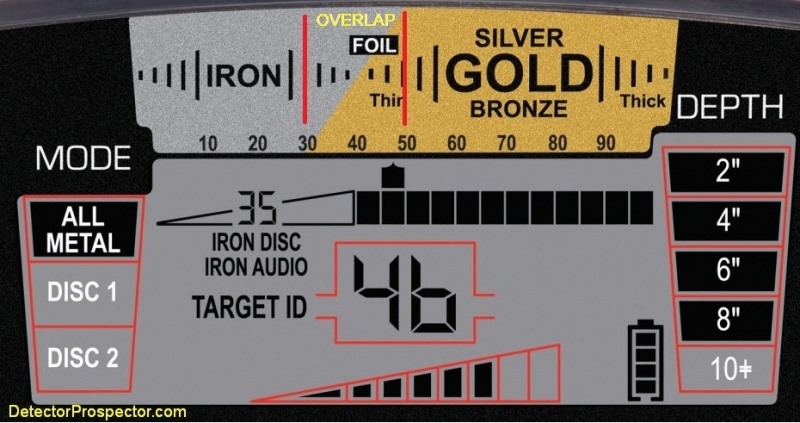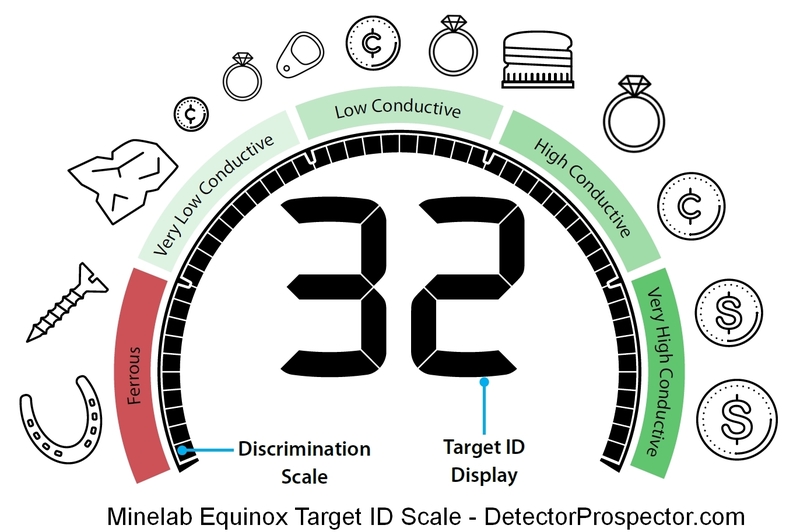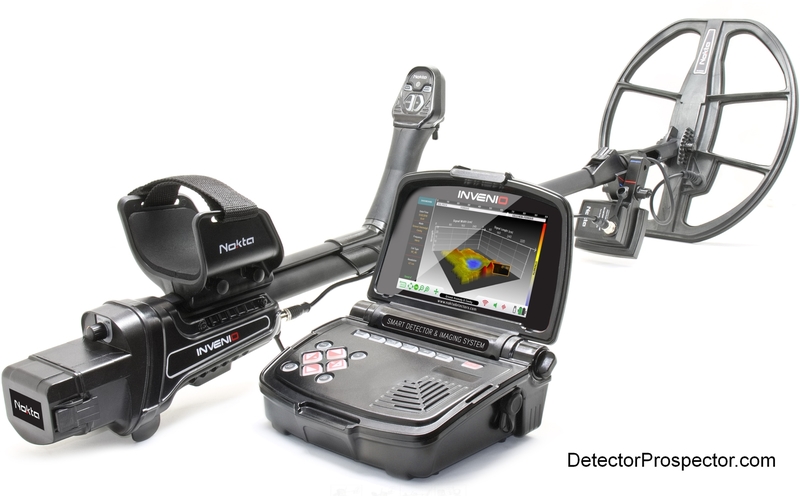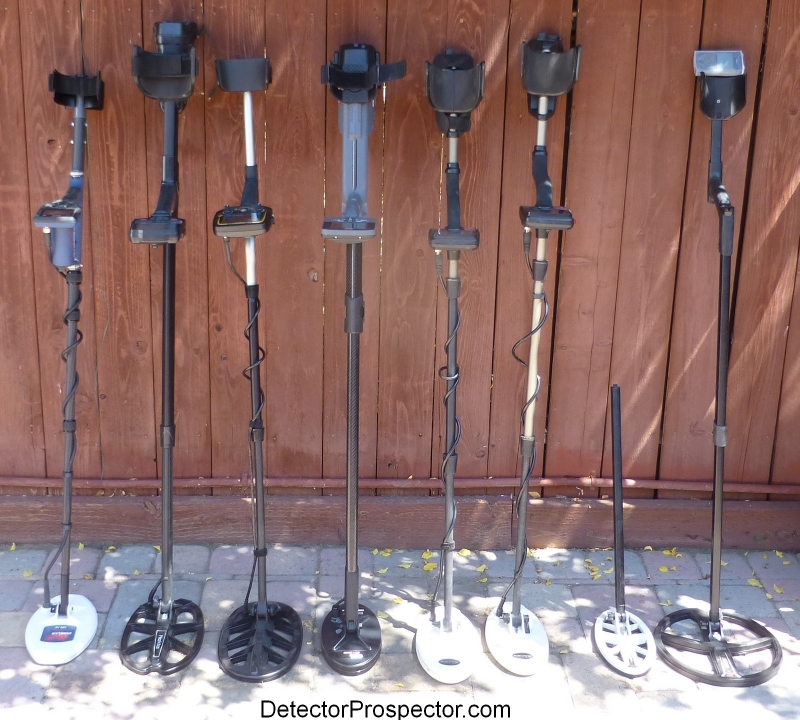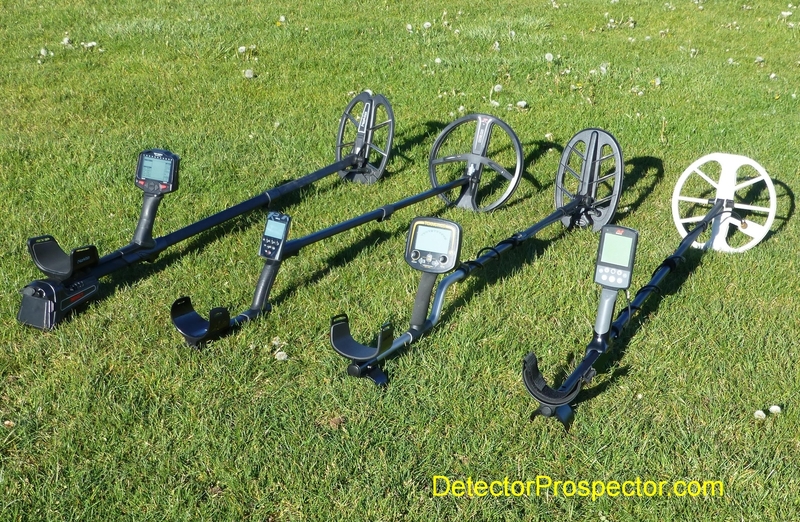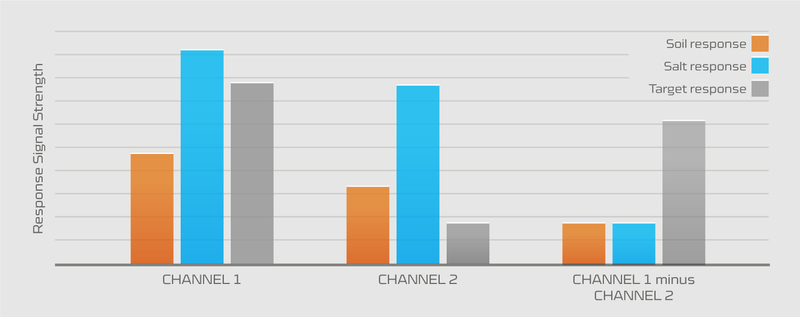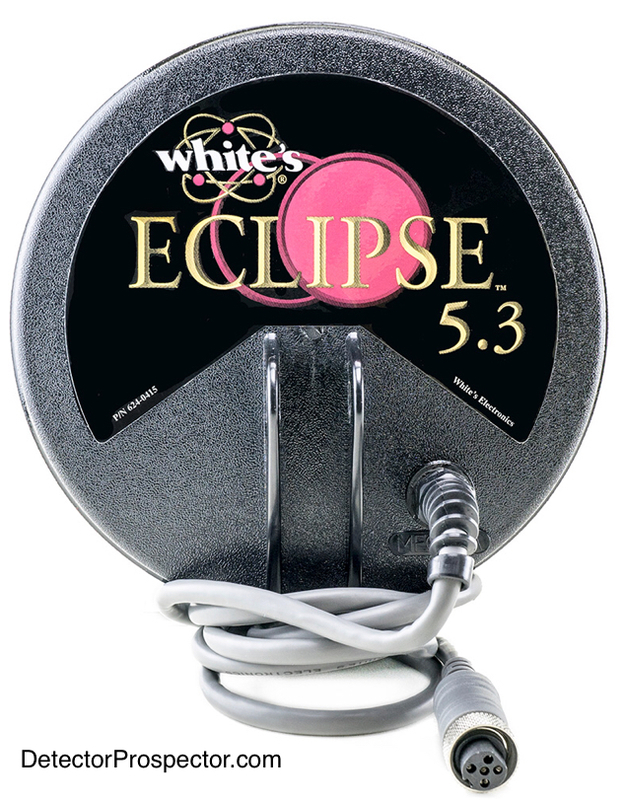-
Posts
19,765 -
Joined
Content Type
Forums
Detector Prospector Home
Detector Database
Downloads
Everything posted by Steve Herschbach
-
The only numbers that actually are designated as ferrous with Equinox are the negative numbers and zero. And for now at least I do not trust even zero and the first few negative numbers to always be ferrous in highly mineralized ground. More on the subject - Tune Out Nails - You Will Miss Gold! Tin, Bolts, Washers, And Other Ferrous Items That Read As Non-Ferrous Adjustable Tone Break Metal Detector Discrimination Really Sucks Metal Detectors With Reliable Target ID Numbers Discriminate, Discriminate, Discriminate! Garrett AT Pro Overlap Range - Note that although 40 is considered the normal start of the non-ferrous range, non-ferrous items can read down to 30 or lower. Detector manufacturers imply this is only tiny foil or gold, but it can also be any larger items at borderline depths. It is not so much what the size or composition of the target is, but the signal strength that the detector has to work with. Weak targets plus highly mineralized ground means any item can be identified as ferrous at borderline depths.
-

Minelab Equinox Essential Information
Steve Herschbach replied to Steve Herschbach's topic in Minelab Equinox Forum
Well, if I left out some particularly useful thread let me know. I cherry picked as best I could but probably missed a few. -
A reference collection of threads about the Minelab Equinox, grouped into rough categories. Minelab Equinox 600 Data & User Reviews Minelab Equinox 800 Data & User Reviews Minelab Equinox Software Update 1.7.5 Released Minelab Equinox Software Update 2.1.12 Released Equinox 600 / 800 Full Instruction Manual (English pdf 5.59 MB) Equinox 600 / 800 Getting Started Guide (English pdf 847.71 KB) Equinox Battery Charging Recommendations And Warnings Minelab Equinox Parts & Accessories Page Some Equinox Videos Done By Purchasers Can I Be Critical Of The Equinox Here? Equinox 600 Versus Equinox 800 Minelab E-trac, CTX 3030, Excalibur Versus Equinox Minelab Multi-IQ Technology Explained Selectable Frequency And Multiple Frequency Tips For Getting Started Equinox and Electrical Interference (EMI) Short Bursts Of Intense Static Or Interference More Tips For Getting Started Even More Getting Started Tips Latest Tips For Getting Started And Yet Another Getting Started Tip Loose Rods, Wobbly Rods, Rod Flex Important Tip - Global Vs Local Settings Minelab Equinox Factory Presets Minelab Equinox Tones & Advanced Tone Options Video - Adjusting Zones, Tones, & Tone Volumes On Equinox External Speaker Not Turning Off When I Plug In Wired Headphones Headphones That Work With Nearly All Detectors Equinox Recovery ( Detect Speed ) Settings Recovery Speed & Target Masking Recovery Speed & The Conveyor Belt Ground Balancing The Minelab Equinox Equinox High Mineral Tips If The Audio Is Open Gate Or The Snap Shot Type ? Iron Bias - What It Is Why Only 50 Points Of Target ID Resolution? Nickels Versus Tabs Bottlecaps & Equinox Target ID Normalization Some Minelab Equinox VDI Numbers Another Equinox Target ID Chart Target ID Numbers Can Vary With Search Profile & Frequency More reference links below the ad..... ads by Amazon... UK Target ID Numbers Canadian Target ID Numbers Australian Target ID Numbers U.S. Gold Coin Target ID Numbers Jewelry Target ID Numbers & Tones How Metal Detector Discrimination Works Iron Falsing A New Way To Do 50 Tone Audio Is Park 2 The Magic Mode?? Park 2 Compared To Field 1 Or Field 2? Park 1 & Field 1 versus Park 2 & Field 2 Multi-IQ Frequency Weighting Differences Between Park & Field Modes Number Of Saved Profile Slots For Custom Settings User Profile Button Gold Nugget Detecting Tips More Tips On Nugget Detecting With Equinox More Equinox Gold Prospecting Tips So What Is Gold Mode Exactly? Equinox First Gold Nugget Photos My First Equinox Gold Nuggets Equinox, Micro Nuggets Target ID Numbers For Gold Nuggets & Gold Jewelry Complete Set Of Equinox Physical Measurements Remove Or Reposition Equinox Handle & Pod Assembly? Waterproof Connections & Audio Jack Sizes Equinox, Lithium Batteries, & Air Travel Equinox Battery Life Test Minelab ML80 Wireless Headphones Check ML80 Battery Level Equinox Future Firmware Updates Minelab Discount For U.S. Military 2018 - Year Of The Equinox! Minelab Equinox - The Best All Around Detector I Have Ever Used! The Simple Reason Why Equinox Is Special The Video I Have Most Enjoyed So Far - What Makes Equinox Special I Saw In A Video Where Equinox Got Beat By.... Early Minelab Testers Question?? Equinox 800 - My Take, Commentary, And Testing Is The Equinox A Deep Seeking Machine?? Gold Coin Found With Equinox
-
Now, no reason for new detectors, remember? There are not many detectors I am interested in but Gold Kruzer is one of them. What the GMT or Gold Bug 2 could have been if they were ever updated. Equinox may be getting the buzz but it is Nokta / Makro that is poised to obsolete a lot of competitive product from slower moving companies.
-
That is not what the word obsolete means. Making products obsolete does not mean the earlier products stop working. I disagree. That remains to be seen. I am seeing no reason at all why Multi-IQ will not supplant single frequency prospecting machines. They are at an inherent disadvantage to true multifrequency. The Eureka was not multifrequency but switchable single frequency.
-

What Makes Equinox Special
Steve Herschbach replied to Steve Herschbach's topic in Minelab Equinox Forum
Funny you mention that Simon. There was quite a bit of complaining about Nokta / Makro putting out new models too quickly! -
And luckily except for those who choose to keep on waiting there is no need to keep on waiting. The future arrived while others were still working in it. Bird in the hand and all that. By the time the wait is over for others to release their first generation products Minelab will be well on the way to the second generation. At some point like the thread title says, facing reality has to take precedence over glowing promises.
-

What Makes Equinox Special
Steve Herschbach replied to Steve Herschbach's topic in Minelab Equinox Forum
There sadly is a point where you can’t teach an old dog new tricks. One of my favorite forums used to be the Metal Detecting Equipment forum. Some really top people used to hang out there and talk detecting. Genuine old timers in the industry. There came a time however when I wanted to discuss some new detector model, and the consensus developed that none of this new digital stuff was as good as those fabulous old analog detectors. I knew then and there the forum was doomed. It turned inward with old people discussing old detectors, and anything new was put down immediately. The forum died a rapid death after that because people like me wanting to keep up on the latest went elsewhere. Metal detecting had always been technology driven, and I think we are entering a new era where multifrequency, combined with computer processors and sophisticated signal processing, is finally delivering results we can see in light weight, affordable packages. The choice in my mind is simple - keep up or get left behind. I don’t want to be that old curmudgeon sitting in a corner waving my old detector at “all the kids and their shiny new toys”. That way lies the pasture, and I am not yet ready to be put out there. -
The World's First Smart Detector & Imaging System that can display the shape, depth and dimensions of underground metals in real time. Ideal for Deep Treasure Hunters, Archaeologists, Municipalities, Utility Companies, CSI and Law Enforcement Agencies. http://noktadetectors.com/invenio-metal-detector.asp
-

Question For Steve: Equinox
Steve Herschbach replied to TennesseeDigger's topic in Minelab Metal Detectors
You asked this question before and it has been answered - are you not checking back on your previous questions/threads? http://www.detectorprospector.com/forum/topic/5840-early-minelab-testers-question/ What data specifically are you seeking that is unavailable given the large number of people who currently have an Equinox in hand? It does not matter what prototype machines did or if they even worked at all. The only thing that matters is the performance of detectors available to the public. Performance questions are being asked and answered daily. I have been answering questions about the Equinox for months - people simply don't want to believe what I have been reporting. -
10/21 Looks like Equinox 600 is fully caught up now with many dealers reporting units in stock and ready to ship. I expect a bunch of 800s will be hitting U.S. shores next. Though with new orders still piling up there will no doubt be some people waiting still past the end of March. Still, progress being made.
-
When I got involved with Equinox I was at the end of a couple years of testing various VLF detectors and I was getting a little frustrated. I kept bumping into what I refer to as “the wall”. This magic limit in my bad ground on any detector getting decent depth and target id accuracy. The mineralized ground here cuts depth to about 50% of the max depths reported back east. Further, any single frequency detector suffers from poor target id, especially regarding “up scaling” of aluminum into the silver coin range. The machines that did best for target id, like my Minelab CTX 3030, lacked the depth of the best single frequency detectors, had poor target separation, and were weak on my favorite target - gold. I discuss this at VLF Detectors & Depth and in particular on this long thread on Euro vs U.S. Style Detectors where I mention I am selling my first CTX. ”I don't need many hours to know a CTX can't get a whisper on targets easily found with other detectors in my ground conditions. Masking is not my problem with the CTX, it is lack of depth on a clear target in the open. Single frequency just packs more punch in my ground, and all the hours in the world won't change that.” I therefore kept coming back to single frequency as having the best depth in my ground and far superior recovery speeds / target separation. Yet try as I might I could never find a single frequency VLF that truly blew me away as being much different than a dozen others. First Texas, Nokta/Makro, and XP had me butting one machine against another for quite some time, all extremely good and yet none really putting the others away as markedly superior. In particular a divide existed between the high frequency units hot on tiny gold and the best silver machines. The ability to play well in saltwater was a major sticking point for me also. I was keeping certain detectors simply because they might see use 10 days out of the year in saltwater. No matter what I seemed forced to own at least three VLF detectors to cover the bases. Long story short, I know my detectors and Equinox came along, and I tossed it in the mix. When I got my hands on Equinox I finally saw something different. The Minelab Equinox has performance characteristics that are unique and observable in the field, and as a result I knew just using it that finally something genuinely different was in my hands. BBS/FBS might be the king of silver, and now I could sense true multifrequency finally coming into its own on a machine both hot on gold and with incredible unmasking capability, the two areas where BBS/FBS are weakest. At the very same time, it matched the best single frequency machines for maximum depth, but while delivering more accurate target id results. My first real Silver Finds Post put it like this: ”I am not trying to prove anything per se here, but what I saw convinced me Equinox has that little bit something extra I have been looking for in a coin detector. It is not purely a depth thing but a combination of depth and speed that seems to pull silver out of places where I had not been having much luck for three years with quite a few VLF detectors.” Despite all the talk about hype I purposefully undersold Equinox since day one except to state I believed it would be a best seller. Pretty safe bet there. Performance though I purposely understated and evaded. My belief was that I would be immediately be discounted as a biased shill. The best way to proceed then, given my faith in the detector, was to just sit back and let others “discover” it. Finally, after some months, that is where we are now. Enough people who really know what they are doing in circumstances similar to mine are seeing the same things I saw, and for the very same reasons. There are those who have not laid hands on an Equinox who continue on telling those who are actually using the detector that they know its “just another same old same old”. This leads to a bit of frustration on the part of those who know better. The bottom line is Equinox has a technological advantage over those detectors, and anyone that thinks this is just another VLF detector like the last couple dozen to hit the market honestly needs to take the blinders off.
-

Info On Diamonds Needed
Steve Herschbach replied to DSMITH's topic in Rocks, Minerals, Gems & Geology
Very unlikely to be diamonds. More likely quartz crystals, nice crystal quartz being common in Arizona. http://www.sedonacrystal.com/ Diamond versus Quartz -

Why Do I Need Waterproof Headphones?
Steve Herschbach replied to Dukester's topic in Minelab Equinox Forum
Water would not get into the internals. However, in saltwater at least I would be concerned about mixing saltwater with electrical current in the earphone jack. Perfect situation for rapid corrosion of the contacts to occur. Fresh water you might get away with it but not for me to try! The wireless should work until the pod itself is submerged a few inches. I would like to wrap a wire around pod and run up to shoulder to see if wireless signal can be extended above water, like Deus does with their antenna kit.- 18 replies
-
- minelab equinox
- headphones and audio
-
(and 1 more)
Tagged with:
-
Lots of good stuff here to chew on! From https://www.minelab.com/anz/go-minelabbing/treasure-talk/equinox-technologies-part-4 EQUINOX Technologies (Part 4) March 20, 2018 10:05am Minelab Electronics This is the fourth installment in a blog series introducing and explaining the technologies inside our new EQUINOX detectors… (Read Parts 1-3 here.) In Part 3 we ended with mentioning the different Multi-IQ “frequency weightings” for the different search profiles. Part 4 explains further why it is not a simple matter of just referring to specific individual frequencies for learning more about Multi-IQ technology. Let’s now consider one of the key practical detecting outcomes and then discuss how this was achieved… “A lot of people are going to be surprised at how well the machine works in saltwater. At the outset we weren’t sure whether reliably detecting micro-jewelry in a conductive medium was even possible, but – with the help of our field testers and the subsequent fine-tuning of the Multi-IQ algorithms – we’ve found the EQUINOX to be more than capable.”Dr Philip Wahrlich Background and considerations While Multi-IQ may appear as ‘magic’ to some, to our team of signal processing experts, it’s the result of a significant number of man-years of development. So where did they start? By assessing the metal detectors and technologies available in the market at that time, along with typical customer perceptions about their practical applications; and actual detecting results achieved: So, an important goal with developing Multi-IQ technology was to retain the above simultaneous multi-frequency advantages AND greatly improve performance in the two key areas where many single-frequency detectors typically excel – fast recovery in iron trash and finding low conductors in all conditions. Speeding up the process Most comparable low-power Continuous Wave transmit-receive detectors (for the same coil size) will have a similar raw detection depth at which the transmit signal penetrates the ground and has the potential to energize a target. To increase detection depth significantly typically requires higher power and Pulse Induction technology. This has advantages for gold prospecting, but discrimination is poor for identifying non-ferrous targets. While we continue to push for depth improvements, Multi-IQ also aims to provide substantial speed improvements, resulting in being able to better find ALL non-ferrous targets among trash in ALL locations. You could therefore say “fast is the new deep, when it comes to EQUINOX!” Let’s start with considering signal processing not as a ‘black box’ where ‘magic’ happens, but more as a complex chain of applied algorithms, where the goal is to more accurately distinguish very small good target signals from ground noise, EMI and iron trash. Now, ‘fast’ by itself is not enough – you can have fast with poor noise rejection and poor target identification, giving no great advantage. Fast is also not just a result of microprocessor speed. Processors operate at much higher speed than is needed to ‘do the signal processing math’. You can think of the signal processing chain broadly as a set of filters and other processes which are applied to the metal detector signals to convert these signals into useable, informative indicators, such as an audio alert or a target ID. For Multi-IQ, keeping the ‘good’ properties of these filters, while keeping them lean and removing unnecessary processing, was an important step towards achieving ‘fast’ for EQUINOX. It’s also important to recognize that these filters are not the coarse filters of the analogue electronics hardware of last century – it all happens in software these days. Perhaps think of the older analogue TV standards versus current digital TV. (Standard digital HDTV has approx. 10 times the resolution of analogue NTSC.) With metal detectors, a fast higher resolution filter set will result in improved target recognition. Factoring in the ground conditions However, speed without accuracy is not enough to produce a “game changer” detector – and improved accuracy cannot be achieved with a single frequency alone. Why? – “multi-frequency has more data-points” Philip Beck, Engineering Manager. This is worth explaining in more detail… All transmit-receive detectors produce in-phase (I) and quadrature (Q) signals that can be processed in various ways depending upon the response received from targets, ground and salt. This processing happens through ‘channels’ that have different sensitivities to the different signals received. It is important to recognize that channels are not exactly frequencies. This is why it is more complex to explain than just correlating optimum frequencies to specific target types. With a single frequency detector there are two basic channels for information (i.e. I and Q) that respond differently to good and bad signals, depending upon the frequency of operation and whether you are looking the the I or Q signal. It is also possible to scale and subtract these signals, while taking ground balance into account, to best maximize good signals and minimize bad signals. You could thus think of single-frequency being Single-IQ, with a limited set of data (e.g. I, Q, I-Q, Q-I) that works well for a particular set of conditions. To further enhance performance for a different set of conditions, you need to change frequency and detect over the same ground again. Therefore a selectable single frequency detector has an advantage with more data available, but not all at once (e.g. I1, Q1, I1-Q1, Q1-I1 OR I2, Q2, I2-Q2, Q2-I2 for as many frequencies that you can select from). Now, getting back to Philip Beck’s “more data-points”, and just looking at two frequencies, a simultaneous multi-frequency detector would be able to process (for example) I1, Q1, I1-Q1, Q1-I1 AND I2, Q2, I2-Q2, Q2-I2 AND I1-Q2, Q2-I1, I2-Q1, Q1-I2 to give better detection results. Increase the number of frequencies further and the number of extra data-points also increases accordingly. What Multi-IQ does is process different optimized channels of information (not just individual frequencies) for the different modes. We have previously explained this as “frequency weighting” (in Part 3), where the various EQUINOX Search Profiles are matched to the respective ground conditions and target types. Here is a very simplified example where you can see the result of processing more than a single channel of information (remember, a channel is not a frequency): Channel 1 has a strong target signal, but the salt signal is stronger still. Channel 2 has weaker signals for soil, salt and the target. If the detector just responded to either Channel 1 or Channel 2, the target would not be heard through the ground noise. If the detector processes a subtraction of the channels (e.g. ch.1-ch.2), then it is possible to ignore the ground noise and extract a strong target signal. Now, think back to the high number of possible combinations of I and Q for simultaneous multi-frequency compared to single-frequency and the frequency weightings for the modes. All of the EQUINOX Park, Field, Beach and Gold Search Profiles have dedicated signal processing to best suit the conditions and types of targets being searched for. Conclusion Multi-IQ = more data-points = sophisticated processing = better ground noise rejection = more finds Just as targets are more sensitive to certain frequencies, so is the ground – an important reason why air testing has inherent limitations when comparing detector performance. As soon as you have ground to consider in the signal processing equation, it can greatly impact on the ability of a single-frequency detector to accurately identify a target. Also, the deeper a target is buried, the weaker the target signal is, relative to the ground signal. The most difficult ground response to eliminate is the salt response, which varies greatly between soil, dry sand, wet sand and seawater. It is not possible to eliminate the salt response and the soil mineralization response (e.g. black sand) with just one frequency. However, within the carefully calibrated Multi-IQ channels, EQUINOX is able to identify both signals and therefore mostly ‘reject’ them (just as you would notch discriminate an unwanted target) BUT still detect gold micro-jewelry. If you haven’t tried EQUINOX yet – why not give it go – with Multi-IQ being fast AND accurate, those diminishing and elusive targets are running out of places to hide! (Part 5 to follow…)
-
So what type of detecting is important to you Andrew87? Is it important the detector be waterproof? Is saltwater performance important? Are you mostly chasing silver or mostly chasing gold? Coins or relics? Is accurate target id in parks important? What are you looking for in a detector?
- 15 replies
-
- makro kruzer
- xp deus
-
(and 1 more)
Tagged with:
-

New - 6" Concentric For MX7 And MX Sport
Steve Herschbach replied to tboykin's topic in White's Metal Detectors
Mike, that would be the 5.3 Eclipse... https://www.whiteselectronics.com/product/eclipse-5-3-6x6-search-coil/?lang=us -

Problem With GPZ WM12 Wireless Module
Steve Herschbach replied to flakmagnet's topic in Minelab Metal Detectors
First step contact Minelab service.... https://www.minelab.com/customer-care/service-support

